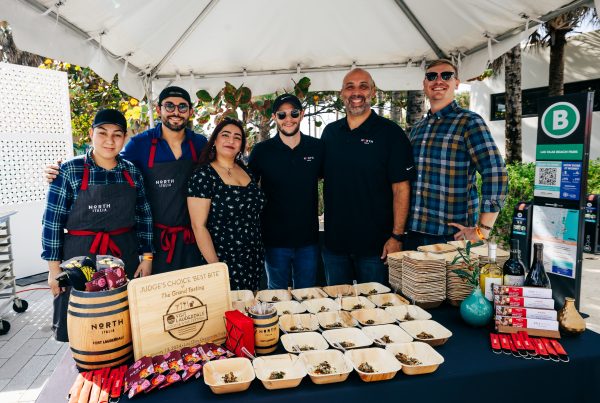So much for easing into the old normal. For his first theatrical production since the pandemic, Kenneth Kay has jumped into the proverbial deep end, portraying no less than 11 characters in a 70-minute, one-man adaptation of Tim O’Brien’s Vietnam-era pseudo-memoir The Things They Carried.
O’Brien, a veteran of that horrific conflict, turned his combat experience into a poetic and therapeutic story collection inspired by his time in both Southeast Asia and his time after deployment. The theatrical version, dramatized by Jim Stowell, revives some of the key stories and characters from O’Brien’s semiautobiographical book, all for one versatile actor to embody.
“It took me four months to learn this thing, because it’s just me up there,” Kay recalls, in an interview this week with Boca, a couple of days after the production’s opening weekend. “It’s been an interesting ride to say the least.”
Timed to run during Memorial Day weekend, “The Things They Carried” concludes its performances at 7 p.m. Thursday to Saturday and 2 p.m. Sunday at Palm Beach Institute for the Entertainment Arts in North Palm Beach. Read on for more of Kay’s insights into this exhaustive and rewarding process.
Is this your first solo play?
No, I’ve done one other, a long time ago, when I was working at the Caldwell Theatre, as part of our performing arts series. But I was much younger then!
Can you speak about how this is different than a traditional multi-actor play?
In this particular play, compared to the other one, I play 11 different characters, primarily the character of Tim O’Brien; the part is based on him and his book, dealing with Nam and all the ramifications of being drafted and the things he encountered over there. The process as an actor is still very similar: You’ve got to learn the words. Working alone, in this time of COVID, provided me an opportunity, when everything else was closed down … I didn’t need to be in a particular theater. I could work from home.
I spent a lot of hours just studying the script, breaking it down into big chunks, and then into little chunks, trying to find the voices of these different people. It’s been a very interesting ride. I was an actor first, before I did these other things—producing, teaching, directing. It’s fun to get back to your roots in that way, because that’s how I started out. I’ve rediscovered some things about myself as an actor, some good things and some stuff that still needs to be worked on. I took it on as a challenge, because the work wasn’t available, and I thought, well, here I am, I’m in my early 70s… can I pack all these words in my head, and spit them out in the order they were written?
Who are some of the 11 characters that you embody in this show?
No. 1 is Tim. He’s the primary person. I felt very simpatico with this guy. I enlisted in the Navy in 1968; he was drafted in 1968, so we share a common history in that regard. I want to be clear: I did not go to Nam. But in my time in service, 1968-1972, I served with a lot of guys who had just come back, or were headed over there. Other characters in the play: his first lieutenant in charge of the platoon, a full-blooded Indian from Oklahoma; the medic, his dad; and a guy by the name of Elroy Berdahl, an 81-year-old man who ran a fishing lodge in Canada. In the play, Tim has this huge crisis of conscience where he makes a decision to head to Canada, but when he gets to the precipice of it, he has a change of heart for a variety of reasons, and it’s Elroy who stands there, bearing witness to this.
These guys are scattered throughout the play; one particular guy who helps Tim in Nam is a veteran who’s been there for at least one tour, a guy by the name of Mitchell Sanders, a grizzled vet who forces Tim to deal with the death that is surrounding him—it’s a war zone—by giving him a catchphrase: “There it is.” Just say, there it is, and move on. You can’t do anything about it, move on. And that voice came from my old drill sergeant in boot camp. That one was easy, because that voice is still in my head—he yelled at me so much in boot camp that I’ll never forget what he sounded like.
Did you consult with any veterans on how to approach any of these characters, or did Tim write such a detailed book that you didn’t need to?
Because of my time in the service, the military jargon, understanding what certain pieces of equipment are and how they operate, and how platoons are formed, and how rank-and-file guys deal with everyday shit, that’s still in my DNA. I come from a semi-military family. My father was a World War II survivor and was on Normandy Beach on D-Day, and was still in the Army Reserves when I enlisted.
But I’ll tell you the truth: I reached out to a couple of my high school buddies who served in Nam, and a couple of other people I know personally from over the years. None of them wanted to talk about it, still. I get that, because my father, he told us one or two little stories that had nothing to do with the blood and the gore. Most of what I know from his service I discovered in scrapbooks that he left behind, and that I inherited after he died.
The play is about redemption and closure and trying to resolve some of the things that happened to him and the loss he suffered, and the loss of his friends. It never goes away. I found that to be true for some of the guys I reached out to. They’re still dealing with it.
What have you learned about the Vietnam War and its effect on the troops, through this process?
I was very lucky that I didn’t go—and grateful that I didn’t go. For some—like this platoon that the story is about—they were in the muck and mire. They were the grunts who were in the field, whose primary mission was to search out, find the enemy and kill the enemy, under any circumstance. And some of those circumstances are described very vividly in the play. So it gave me a renewed appreciation for what those guys had to deal with, and I feel such compassion and gratitude for their service, even though I was the same age.
But a lot of these guys came back to dead silence, or people spitting on them. And there are 58,000 names on that wall in Washington. One of the reasons I wanted to do this was as a tribute.
It’s a tiny theater, only 30 seats. But it’s a great venue for this kind of play, because the audience is 3 feet away. I’m not trying to be in their face, but it’s a “bench and a pool of light” kind of theater, where it’s pure storytelling. I reached out to Matt Corey to do the sound design for me, so we do have a little sound support. But it’s essentially lights up, and lights down, a little sound effects, and me just going through the various stages of the guy’s life, and his return to Nam 20 years after the fact with his daughter to try to find some closure for some of the things that happened.
Have you received any feedback from veterans?
Yes, we reached out to all the veterans groups up here. I’ve had a few come up to me after the play, and they were just very nice. They’ll say, “as much as I don’t like being reminded of this, it’s important. And thank you for doing it.” And that’s a great review, and it makes all these months of trying to cram these words in my old brain worth it.
We’re still lingering with COVID; has that altered the typical relationship between the actor and the audience in terms of the intimacy, the connection?
Everyone here on staff is fully vaxxed; it’s mask-optional. And there’s room to spread out if we’re not sold out, so there’s an empty seat, sometimes, between groups. If there’s less than 50 percent, there’s plenty of room. And we allow the audience to make that decision, and let them know that it’s a very safe environment. Anybody who comes in, and is fully vaccinated, they’re going to feel safe. Otherwise I wouldn’t have done it.
“The Things They Carried” runs Thursday to Sunday at Palm Beach Institute for the Entertainment Arts, 115 U.S. Highway 1, North Palm Beach. Tickets cost $20 general admission and $15 for veterans. Call 561/743-9955.
For more of Boca magazine’s arts and entertainment coverage, click here.







